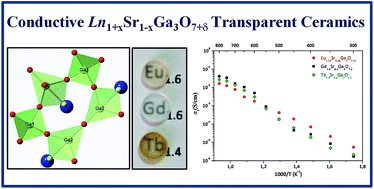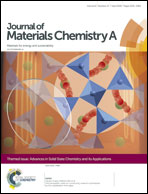First transparent oxide ion conducting ceramics synthesized by full crystallization from glass†
Abstract
We propose here to use full crystallization from glass as an innovative process to elaborate completely dense transparent oxide conductors. This is demonstrated in the case of new non-stoichiometric Ln1+xSr1−xGa3O7+δ (Ln = Eu, Gd or Tb) melilite ceramics which show bulk conductivity greater than 0.02 S cm−1 at 500 °C. Full crystallization from glass is used here as an alternative method to conventional solid state synthesis in order to elaborate new crystalline phases, i.e. melilite compositions with small rare earth elements, which could not be synthesized by a solid state reaction. The materials are stable up to 800 °C under cycled conductivity measurement conditions. Moreover, as melilite compositions show similar glass and crystalline phase densities, the process can produce fully dense ceramics with thin grain boundaries. Coupled to the limited birefringence of the melilite structure, such materials retain some of the glass transparency during crystallization, leading to the first transparent oxide ion conducting ceramics. This work may open a way to a new class of fully dense, and possibly transparent, solid state electrolytes.

- This article is part of the themed collection: Advances in Solid State Chemistry and its Applications


 Please wait while we load your content...
Please wait while we load your content...